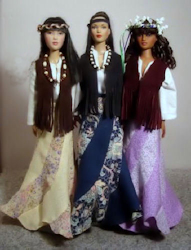|
Computer Aided Pattern Design
by Don McCunn RTW Fitting IssuesOver the years of showing people how to create Bespoke patterns I have constantly been made aware that body shapes are like DNA. They may look the same but there will always be differences. Back in the 1970s I first witnessed this when one of the students in my Bespoke pattern design classes made a wedding dress for her twin sister. They shared a common RTW wardrobe where either sister could wear anything in their wardrobe including shoes. My student made a simple Medieval styled wedding dress. She wanted to see how she would look in it. She was very surprised when she found she could not even get into it.
I have had students in my Bespoke pattern design classes ask how they could create patterns for Ready-to-Wear. My only response has been to say that just because a garment fits you, doesn't mean it will fit anyone else. I wrote Fashion & Costume Design in Quarter Scale to show the different ways body shapes vary. I include the patterns and instructions for making quarter-scale dress forms for 13 models I have personally measured and fit. These Mini-Mes can be used to verify where a given design is likely to fall on a spectrum from Bespoke to RTW. |
RTW Industry's Fitting IssuesWhile the information here is intended for Independent Designers, fitting issues are very relevant for the RTW industry. There is an article written in Italian on SizeBay's website translated as "Why Clothing Sizes Are Inconsistent Across Brands." SizeBay's business is consulting with major garment manufacturers to solve the complexity of selling clothes by eliminating size uncertainty. Here are some of the points this article makes that are relevant to the work of Independent Designers.
Lindsey's Fitting IssuesI was surprised when Lindsey asked for help with her RTW patterns. She had already been running a sucessful business for over a dozen years so I asked her what issues she had with the patterns she had been using. This is what she said.
She had been making her patterns for shirts using a pattern design program which shall remain nameless. I had a similar experience when I was approached by a company making pattern design software that wanted to use my approach to pattern making. When they sent me sample files I found it was impossible to use their software to adjust the patterns for fit or design so I declined to work with them. The key to making RTW following the approach described here is that the Studio software does not create patterns, it provides the necessary CAD functions to draw and edit straight and curved lines giving complete control over the shape of patterns and a scaling function for changing them to different sizes. Copyright © 2024 by Donald H. McCunn |
